This building stands on the site of three private residences, similar to the adjacent properties built in the early 19th century. This short row was called Albion Place, now the street name for what was the west end of Borough Road. Doctor Henry Renney (‘Public Vaccinator’ for Sunderland) was living at Albion Place in 1890. Ten years later, his thoughts on public vaccination were published in the British Medical Journal. The doctor advocated the use of the Cooper Rose vaccinator which he carried with ‘half an ounce of antiseptic, more than enough for nine arms’.
Photographs, illustration and text about The Cooper Rose.
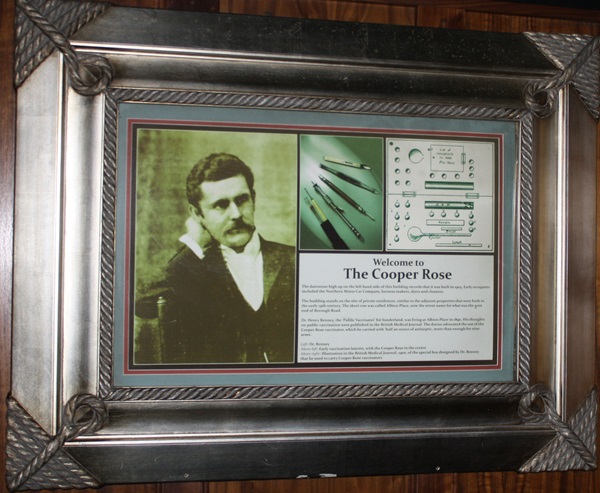
The text reads: The datestone high upon the left hand side of this building record that it was built in 1903. Early occupants included the Northern Motor Car Company, harness makers, dyers and cleaners
The building stands on the site of private residence, similar to the adjacent properties that were built in the early 19th century. The short row was called Albion Place, now the street name for what was the west end of Borough Road.
Dr. Henry Renney, the ‘Public Vaccinator’ for Sunderland, was living at Albion Place in 1890. His thoughts on public vaccination were published in the British Medical Journal. The doctor advocated the use of the Cooper Rose vaccinator, which he carried with ‘half an ounce of antiseptic, more than enough for none arms’.
Left: Dr Renney
Above left: Early vaccination lancets, with the Cooper Rose in the centre
Above right: Illustration in the British Medical Journal, 1900, of the special box designed by Dr Renney that he used to carry Cooper Rose vaccinations.
A plaque documenting the history of The Cooper Rose.
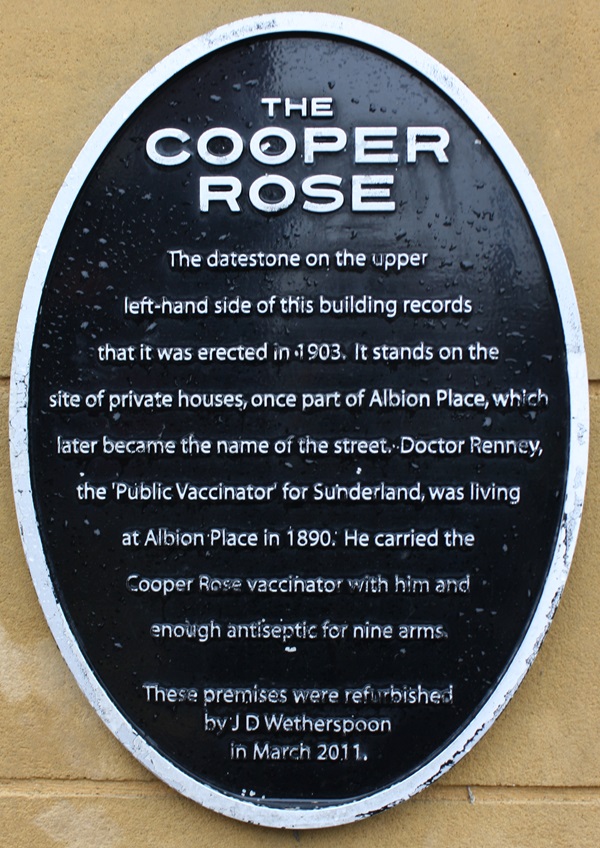
The text reads: the datestone high upon the left hand side of this building record that it was built in 1903. It stands on the site of private houses, once part of Albion Place, which later became the name of the street. Doctor Renney, the ‘Public Vaccinator’ for Sunderland, was living at Albion Place in 1890. He carried the Cooper Rose vaccinator with him and enough antiseptic for nine arms.
These premises were refurbished by J D Wetherspoon in March 2011.
An illustration and text about Sir Henry Havelock.
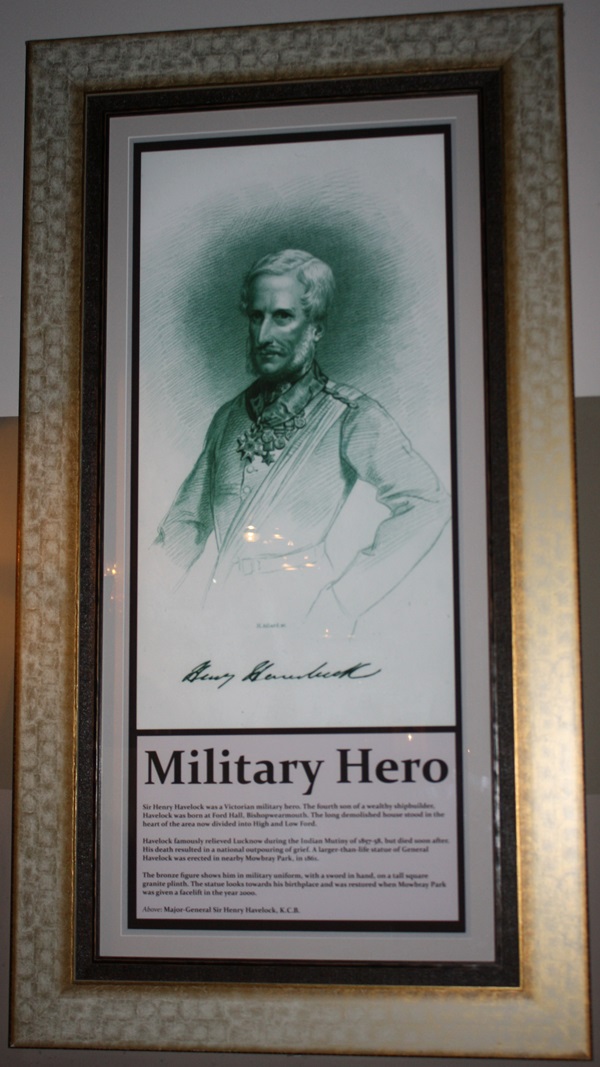
The text reads: Sir Henry Havelock was a Victorian military hero. The fourth son if a wealthy shipbuilder, Havelock was born in Ford Hall, Bishopwearmouth. The long demolished house stood in the heart of the area now divided into High and Low Ford.
Havelock famously relieved Lucknow during the Indian Mutiny of 1856-58, but died soon after. His death resulted in a national outpouring of grief. A larger-than-life statue of General Havelock was erected in nearby Mowbray Park, in 1861.
The bronze figure shows him in military uniform, with a sword in hand, on a tall square granite plinth. The statue looks towards his birthplace and was restored when Mowbray Park was given a facelift in the year 2000.
Above: Major General Sir Henry Havelock, K.C.B.
Photographs of General Havelock and Lady Havelock and Havelock’s daughters Puss and Nora, 1859.
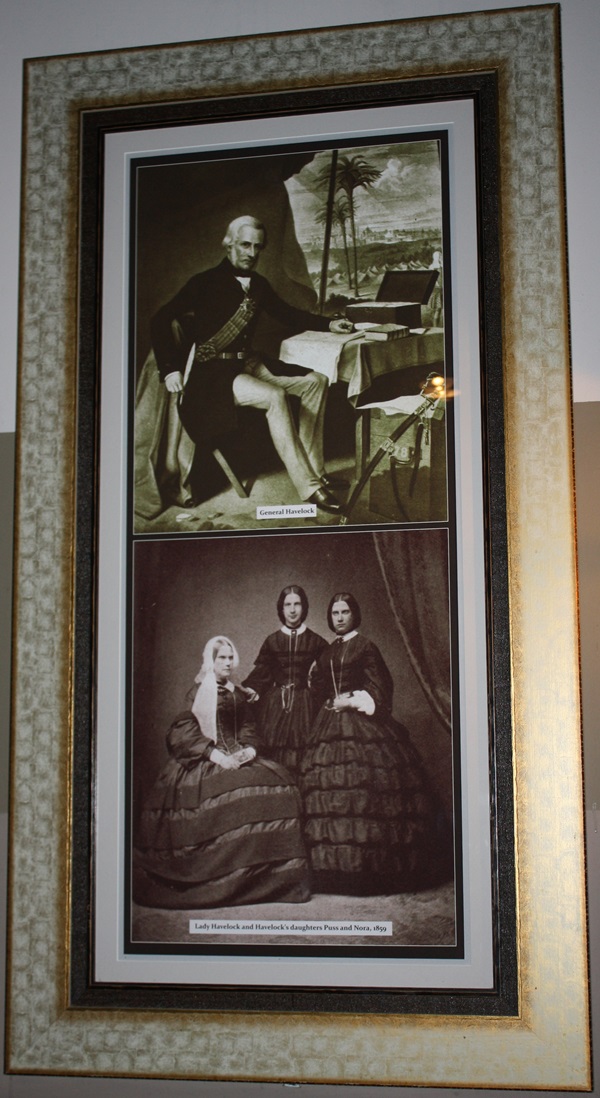
Illustrations and text about John Lilburne.
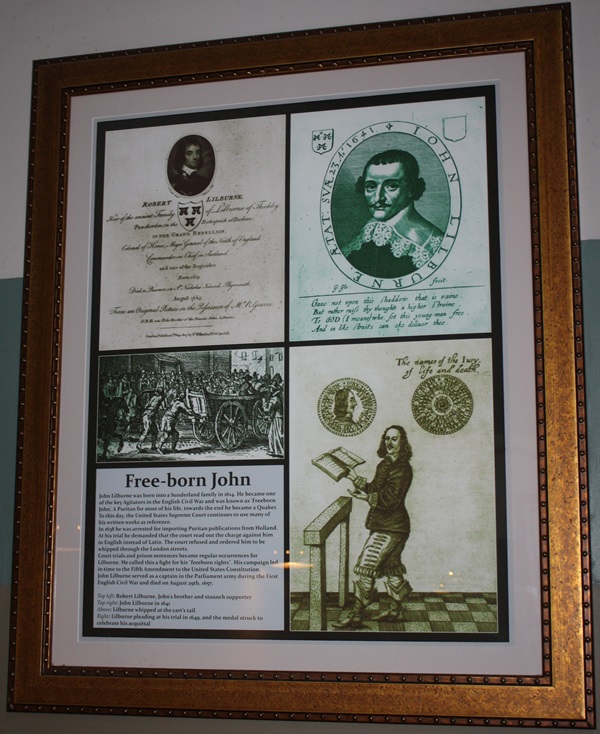
The text reads: John Lilburne was born into a Sunderland family in 1614. He became one of the key Agitators in the English Civil War and was known as ‘Freeborn John’. A Puritan for most of his life, towards the end became a Quaker. To this day, the United States Supreme Court continues to use many of his written works as a reference.
In 1638 he was arrested for importing Puritan publications from Holland. At his trial he demanded that the court read out the charge against him in English instead of Latin. The court refused and ordered him to be whipped through the London streets.
Court trials and prison sentences became regular occurrences for Lilburne. He called this a fight for his ‘freeborn rights’. His campaign led in time to the Fifth Amendment to the United States Constitution. John Lilburne served as a captain in the Parliament army during the First English Civil War and died on August 29th, 1657.
Top left: Robert Lilburne, John’s brother and staunch supporter
Top Right: John Lilburne in 1641
Above: Lilburne whipped at cart’s tail
Right: Lilburne pleading at his trial in 1649, and the medal struck to celebrate his acquittal.
Illustrations and text about civic pride.
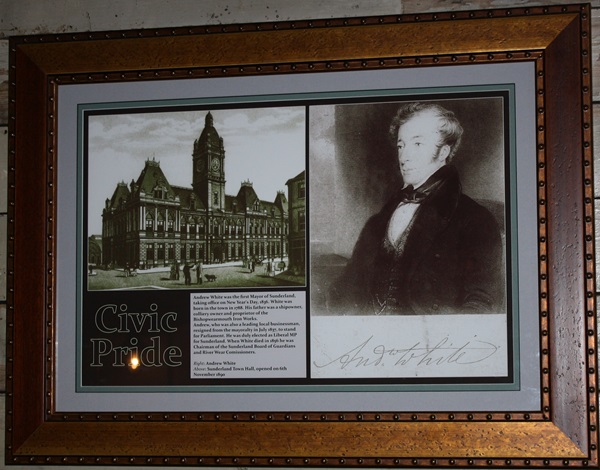
The text reads: Andrew White was the first Mayor of Sunderland, taking office on New Year’s Day, 1836. White was born in the town in 1788. His father was a shipowner, colliery owner and proprietor of the Bishopwearmouth Iron Works.
Andrew, who was also a leading local businessman resigned from the mayoralty in July 1837, to stand for Parliament. He was duly elected as Liberal MP for Sunderland. When White died in 1856 he was Chairman of the Sunderland Board of Guardians and River Wear Commissioners.
Right: Andrew White
Above: Sunderland Town Hall, opened 6th November 1890.
Photographs and text about Edward Chapman.
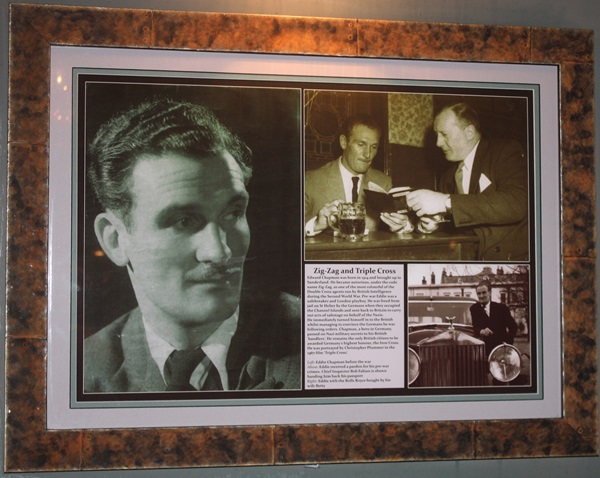
The text reads: Edward Chapman was born in 1914 and brought up in Sunderland. He became notorious, under the code name Zig-Zag, as one of the most colourful of the Double Cross agents run by British Intelligence during the Second World War. Pre-war Eddie was a safebreaker and London playboy. He was freed from jail on St Helier by the Germans when they occupied the Channel Islands and sent back to Britain to carry out acts of sabotage on behalf of the Nazis.
He immediately turned himself in to the British whilst managing to convince the Germans he was following orders. Chapman, a hero in Germany, passed on Nazi military secrets to his British ‘handlers’. He remains the only British citizen to be awarded Germany’s highest honour, the Iron Cross. He was portrayed by Christopher Plummer in the 1967 film ‘Triple Cross’.
Left: Eddie Chapman before the war
Above: Eddie received a pardon for his pre-war crimes. Chief Inspector Bob Fabian is shown handing him back his passport
Right: Eddie with the Rolls Royce bought by his wife Betty.
A photograph of Eddie Chapman just after World War II.
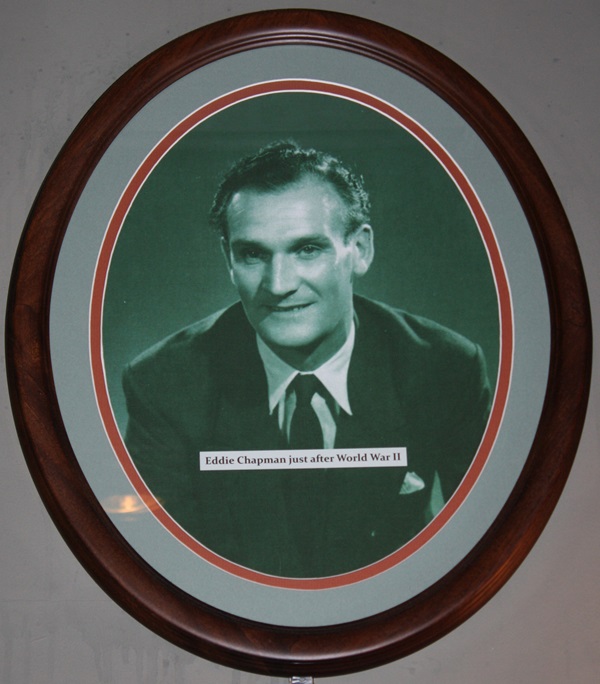
A photograph of Christopher Plummer as Chapman in Triple Cross, 1967.
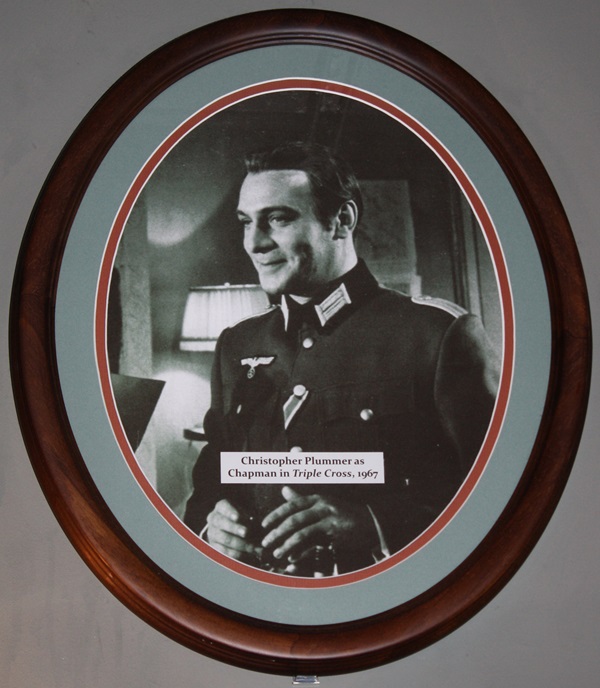
Photographs, illustrations and text about Joseph Havelock Wilson.
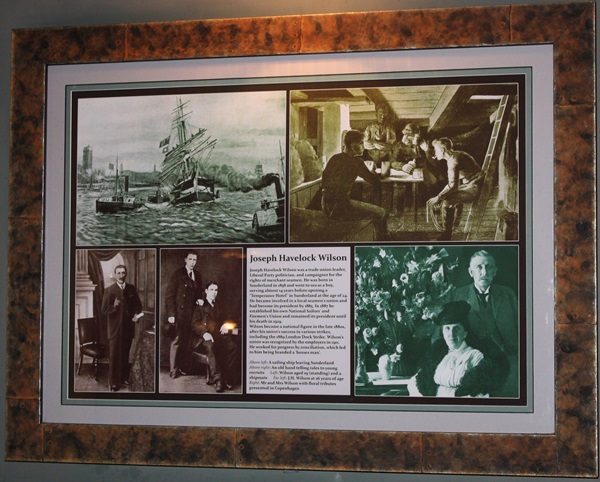
The text reads: Joseph Havelock Wilson was a trade union leader, Liberal Party politician, and campaigner for the rights of merchant seamen. He was born in Sunderland in 1858 and went to sea as a boy, serving almost 14 years before opening a “Temperance Hotel” in Sunderland at the age of 24. He became involved in a local seamen’s union and had become its president by 1885. In 1887 he established his own National Sailors’ and Firemen’s Union and remained its President until his death in 1929.
Wilson became a national figure in the late 1880’s, after his union’s success in various strike, including the 1889 London Dock Strike. Wilson’s union was recognised by the employers in 1911. He worked for progress by conciliation, which led to him being branded a ‘bosses man’.
Above left: A sailing ship leaving Sunderland
Above right: An old hand telling tales to young recruits
Left: Wilson aged 19 (standing) and a shipmate
Far left: J.H. Wilson at 26 years of age
Right: Mr and Mrs Wilson with floral tributes presented in Copenhagen.
A photograph of Joseph Havelock Wilson aged 28.
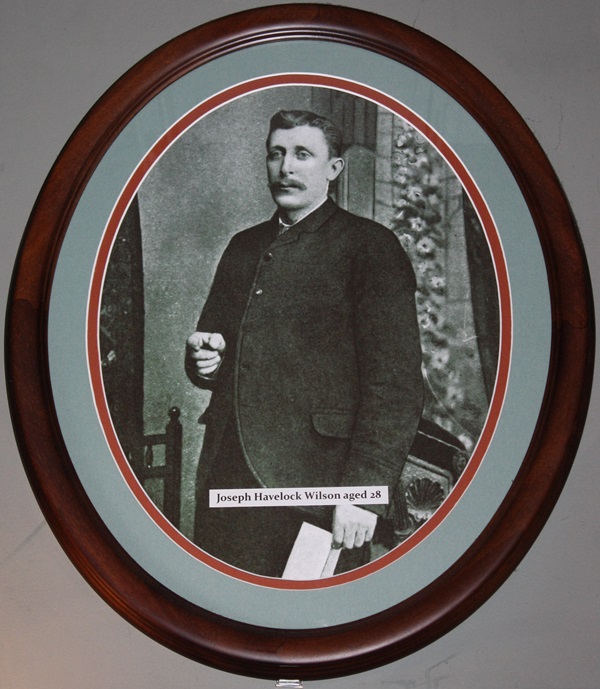
A photograph of J.H. Wilson and family in 1894.
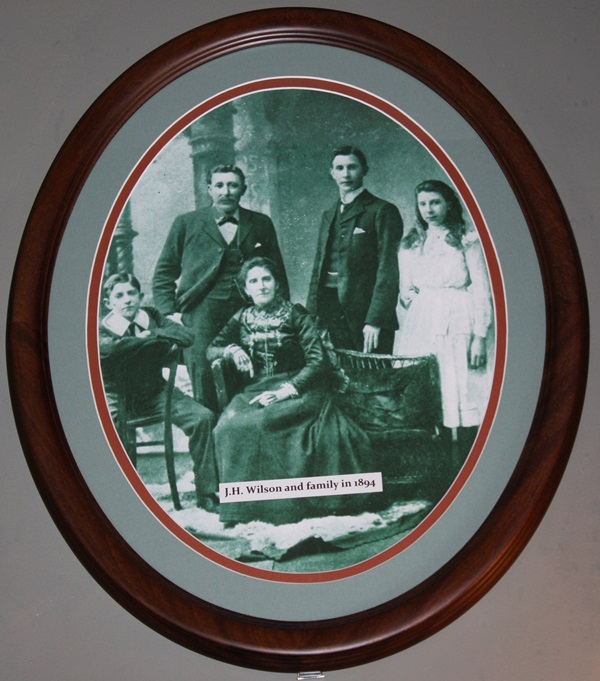
Prints and text about John George Lambton – ‘Radical Jack’.
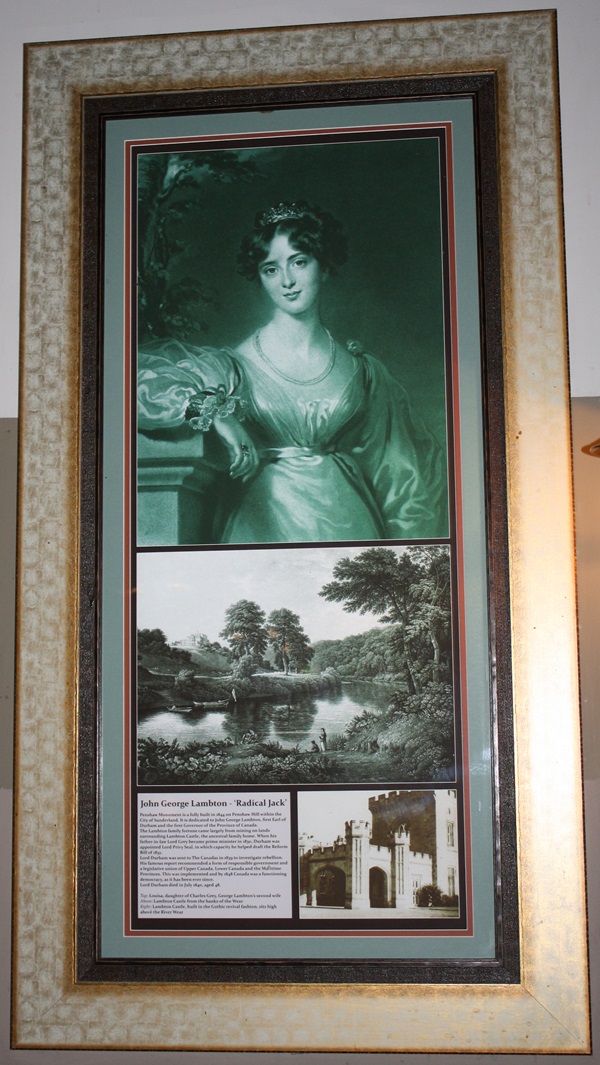
The text reads: Penshaw Monument is a folly built in 1844 on Penshaw Hill within the City of Sunderland. It is dedicated to John George Lambton, first Earl of Durham and the first Governor of the Providence of Canada.
The Lambton family fortune came largely from mining on lands surrounding Lambton Castle, the ancestral family home. When his father-in-law Lord Grey became prime minister in 1830, Durham was appointed Lord Privy Seal, in which capacity he helped draft the Reform Bill of 1832.
Lord Durham was sent to The Canadas in 1839 to investigate rebellion. His famous report recommended a form of responsible government and a legislative union of Upper Canada, Lower Canada and the Maritime Provinces. This was implemented and by 1848 Canada was a functioning democracy, as it has been ever since.
Lord Durham died in July 1840, aged 48.
Top: Louisa, daughter of Charles Grey, George Lambton’s second wife
Above: Lambton Castle from the banks of the Wear
Right: Lambton Castle, built in the Gothic revival fashion, sits high above the River Wear.
Prints of John George Lambton.
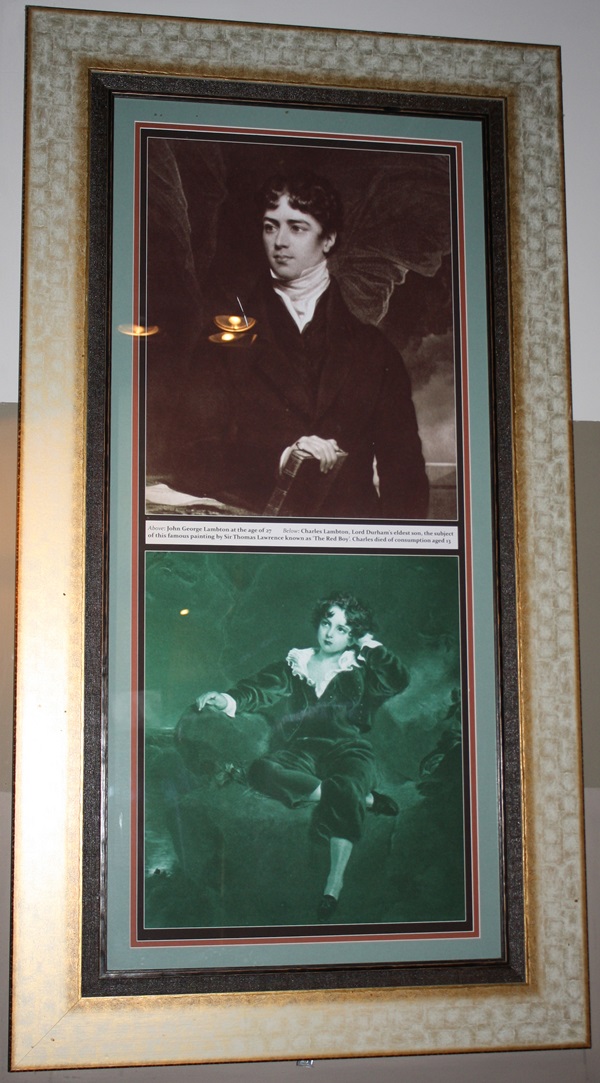
Above: John George Lambton at the age of 27
Below: Charles Lambton, Lord Durham’s eldest son, the subject of this famous painting by Sir Thomas Lawrence known as ‘The Re Boy’. Charles died of consumption aged 13.
Prints, photograph and text about Jack Crawford.
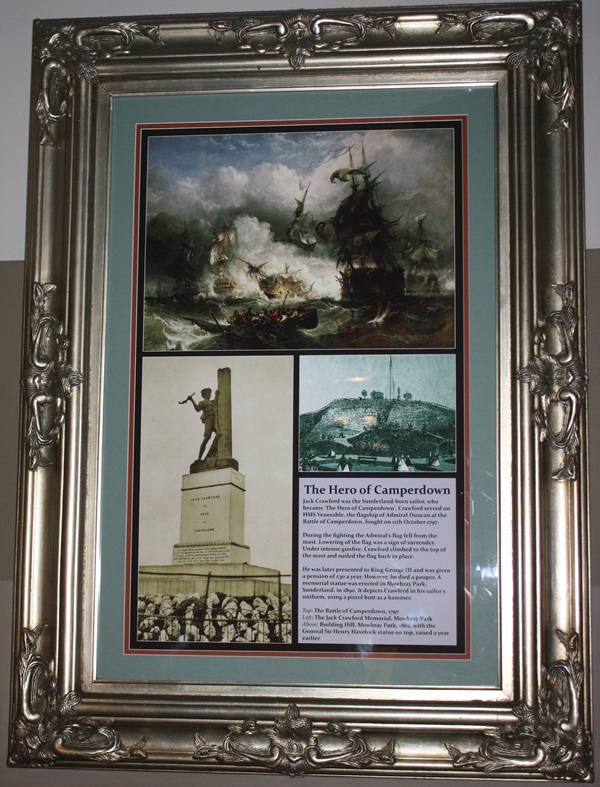
The text reads: Jack Crawford was the Sunderland-born sailor, who became “The Hero of Camperdown”. Crawford served on HMS Venerable, the flagship of Admiral Duncan at the Battle of Camperdown, fought on 11th October 1797.
During the fighting the Admiral’s flag fell from the mast. Lowering of the flag was a sign of surrender. Under intense gunfire, Crawford climbed to the top of the mast and nailed the flag back in place.
He was later presented to King George III and was given a pension of £30 a year. However, he died a pauper. A memorial statue was erected in Mowbray Park, Sunderland in 1890. It depicts Crawford in his sailor’s uniform, using a pistol butt as a hammer
Top: The Battle of Camperdown, 1797
Left: The Jack Crawford Memorial, Mowbray Park
Above: Building Hill, Mowbray park, 1862, with the General Sir Henry Havelock statue on top, raised a year earlier.
A photograph of Ford Hall, c1900, built in 1785, the home of the Havelocks and later of several ship-building families.
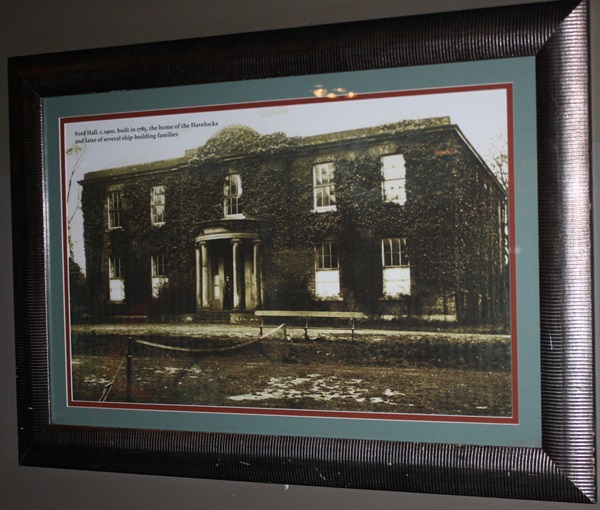
Photographs and text about Sunderland University.
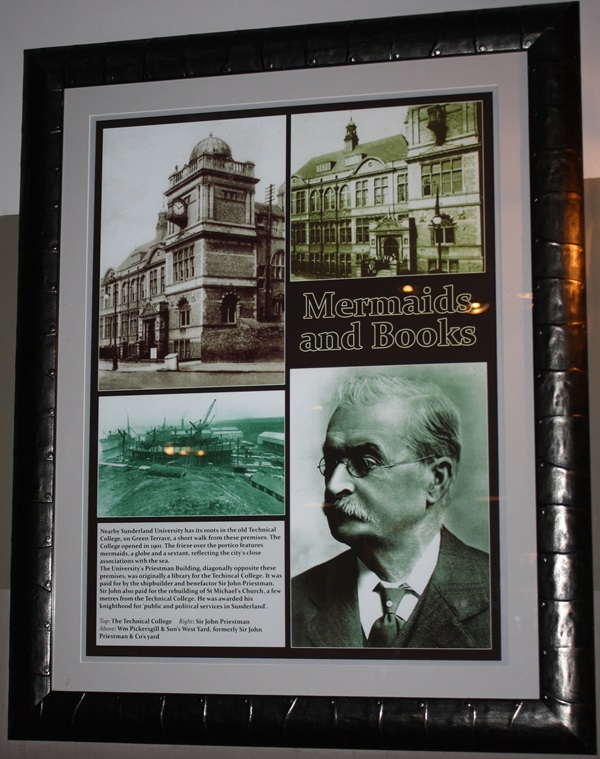
The text reads: Nearby Sunderland University has its roots in the old Technical College, on Green Terrace, a short walk from these premises. The College opened in 1901. The frieze over the portico features mermaids, a globe and a sextant, reflecting the city’s close associations with the sea.
The University’s Priestman Building, diagonally opposite these premises, was originally a library for the Technical College. It was paid for by the shipbuilder and benefactor Sir John Priestman. Sir John also paid for the rebuilding of St Michael’s Church, a few metres from the Technical College. He was awarded his knighthood for ‘public and political services in Sunderland’.
Top: The Technical College
Right: Sir John Priestman
Above: Wm Pickersgill & Son’s West Yard, formerly Sir John Priestman & Co’s yard.
Photographs, illustrations and text about Joseph Wilson Swan.
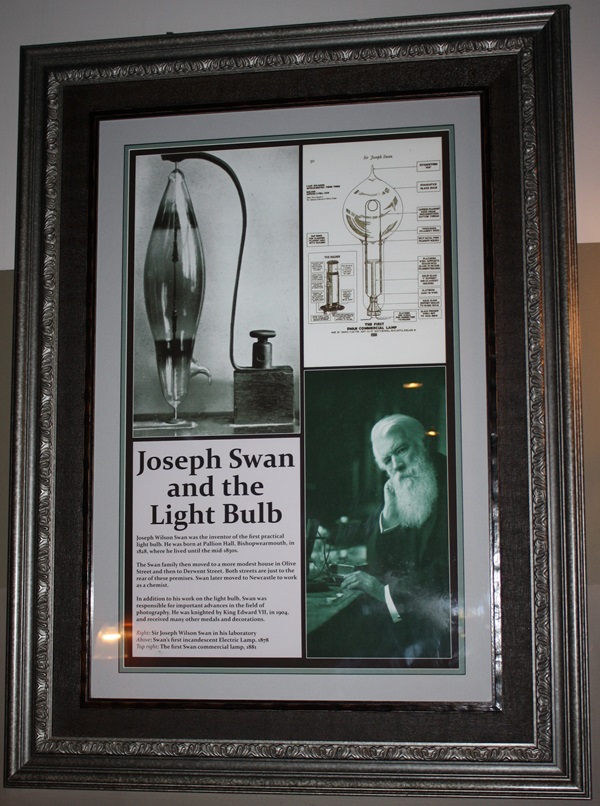
The text reads: Joseph Wilson Swan was the inventor of the first practical light bulb. He was born at Pallion Hall, Bishopwearmouth, in 1828, where he lived until the mid-1830s.
The Swan family then moved to a more modest house in Olive Street and then to Derwent Street. Both streets are just to the rear of these premises. Swan later moved to Newcastle to work as a chemist.
In addition to his work on the light bulb, Swan was responsible for important advances in the field of photography. He was knighted by King Edward VII, in 1904, and received many other medals and decorations.
Right: Sir Joseph Wilson Swan in his laboratory
Above: Swan’s first incandescent Electric Lamp, 1878
Top right: The first Swan commercial lamp, 1881.
Prints and text about Clarkson Stanfield.
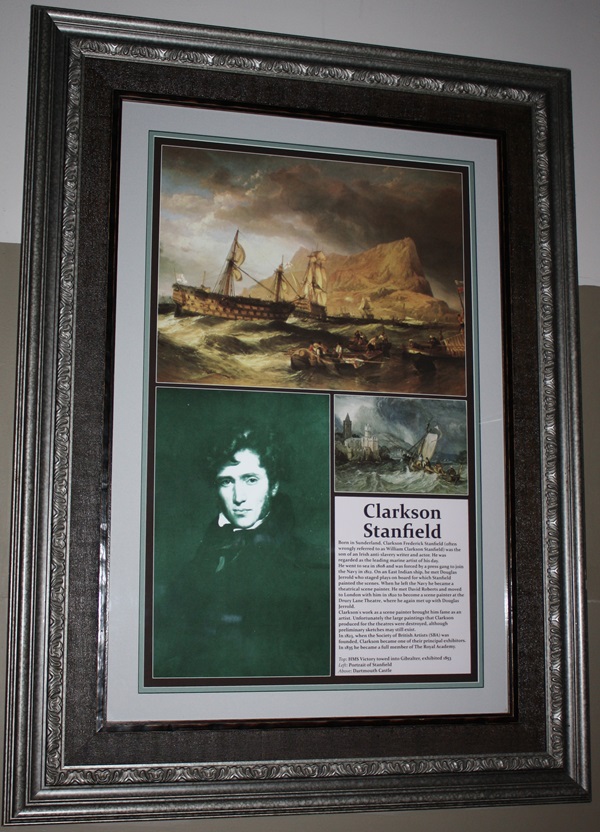
The text reads: Born in Sunderland, Clarkson Fredrick Stanfield (often wrongly referred to as William Clarkson Stanfield) was the son of an Irish anti-slavery writer and actor. He was regarded as the leading marine artist of his day.
He went to sea in 1808 and was forced by a press gang to join the Navy in 1812. On an East Indian ship, he met Douglas Jerrold who staged plays on board for which Stanfield painted the scenes. When he left the Navy he became a theatrical scene painter. He met David Roberts and moved to London with him in 1820 to become a scene painter at the Drury Lane Theatre, where he again met up with Douglas Jerrold.
Clarkson’s work as a scene painter brought him fame as an artist. Unfortunately the large paintings that Clarkson produced for the theatres were destroyed, although preliminary sketches may still exist.
In 1823, when the Society of British Artists (SBA) was founded, Clarkson became one of their principal exhibitors. In 1835 he became a full member of The Royal Academy.
Top: HMS Victory towed into Gibraltar, exhibited 1853
Left: Portrait of Stanfield
Above: Dartmouth Castle.
Illustrations, photograph and text bishops, monks and scholars.
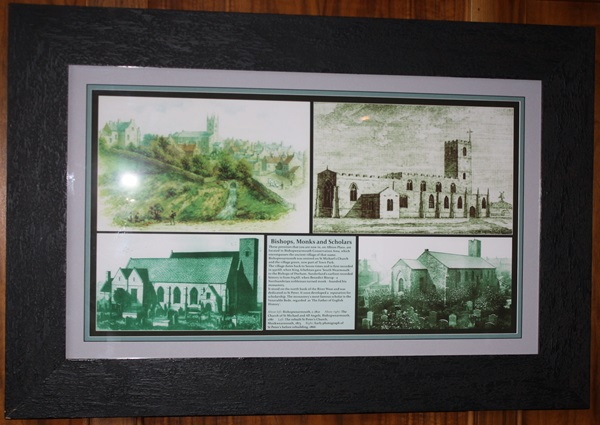
The text reads: These premises that you are now in, on Albion Place, are located in Bishopwearmouth Conservation Area, which encompasses the ancient village of that name.
Bishopwearmouth was centred on St Michael’s Church and the village green, now part of Town Park.
The village dates back to Saxon times and is first recorded in 930AD, when King Athelstan gave ‘South Wearmouth’ to the Bishops of Durham. Sunderland’s earliest recorded history is from 674AD, when Benedict Biscop – a Northumbrian nobleman turned monk – founded his monastery.
It stood on the north bank of the River Wear and was dedicated to St Peter. It soon developed a reputation for scholarship. The monastery’s most famous scholar is the Venerable Bede, regarded as ‘The Father of English History’.
Above left: Bishopwearmouth, c.1810
Above right: The Church of St Michael and All Angels, Bishopwearmouth, 1787
Left: The rebuilt St Peter’s Church, Monkwearmouth, 1873
Right: Early photograph of St Peter’s before rebuilding, 1866.
An acrylic painting entitled Queen Alexandra Bridge, by Emma Holliday.
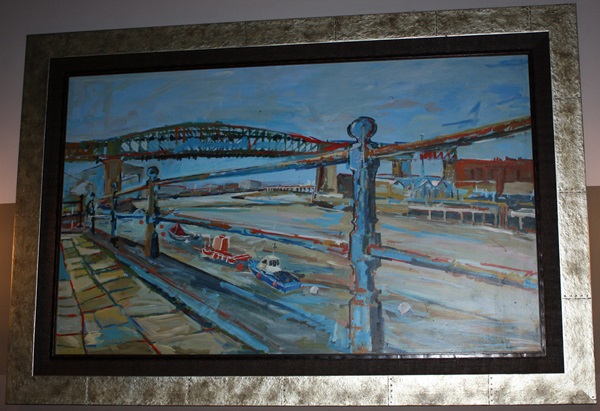
Emma is a painter living and working in the North East. Originally from the South, she has been in this area for over twenty years. Emma works in acrylic and oil, painting outside in all weathers.
An acrylic painting entitled Cranes on the Wear, by Emma Holliday.
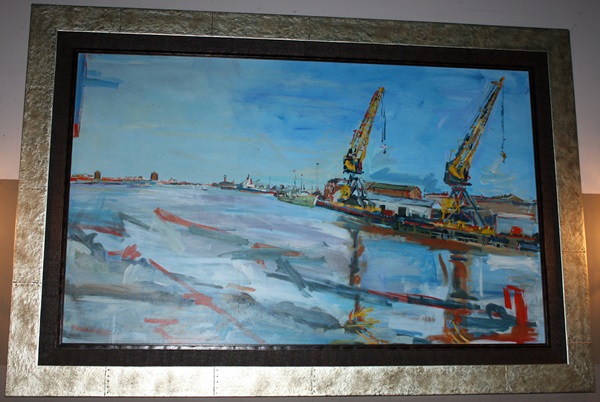
A sculpture entitled Propel, by Stephen Lunn FWCB, Blacksmith, Morpeth.
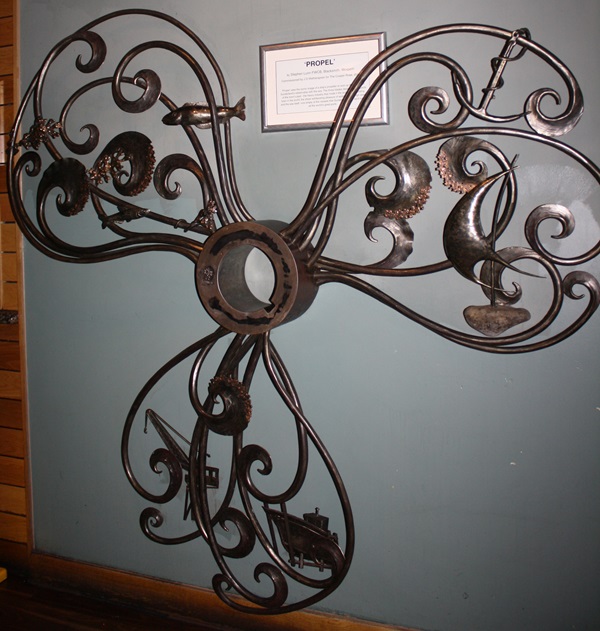
‘Propel’ uses iconic image of a ship’s propeller to sum up the history of Sunderland’s relationship with the sea. The three blades depict three aspects of the town’s past – the heavy industry that made it the largest shipbuilding town in the world; the sheer exhilarating pleasure of sailing on the high seas and the sea itself, now empty of the vessels that Sunderland once sent out to all the world’s great ports.
External photograph of the building – main entrance.
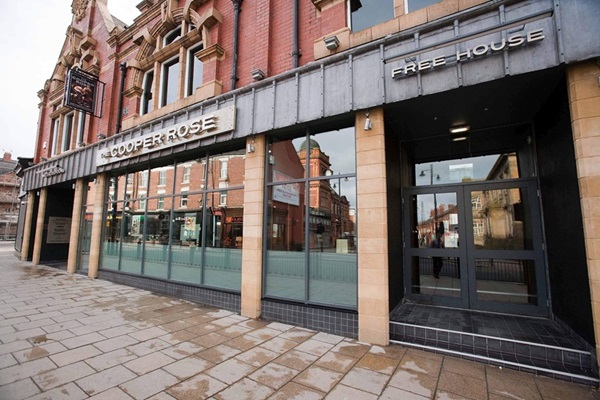
If you have information on the history of this pub, then we’d like you to share it with us. Please e-mail all information to: pubhistories@jdwetherspoon.co.uk
Photographs, illustration and text about The Cooper Rose.